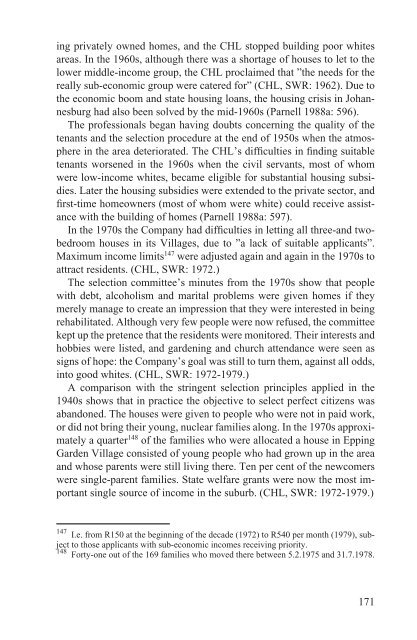The Making of a Good White - E-thesis - Helsinki.fi
The Making of a Good White - E-thesis - Helsinki.fi
The Making of a Good White - E-thesis - Helsinki.fi
You also want an ePaper? Increase the reach of your titles
YUMPU automatically turns print PDFs into web optimized ePapers that Google loves.
ing privately owned homes, and the CHL stopped building poor whites<br />
areas. In the 1960s, although there was a shortage <strong>of</strong> houses to let to the<br />
lower middle-income group, the CHL proclaimed that ”the needs for the<br />
really sub-economic group were catered for” (CHL, SWR: 1962). Due to<br />
the economic boom and state housing loans, the housing crisis in Johannesburg<br />
had also been solved by the mid-1960s (Parnell 1988a: 596).<br />
<strong>The</strong> pr<strong>of</strong>essionals began having doubts concerning the quality <strong>of</strong> the<br />
tenants and the selection procedure at the end <strong>of</strong> 1950s when the atmosphere<br />
in the area deteriorated. <strong>The</strong> CHL’s dif<strong>fi</strong>culties in <strong>fi</strong>nding suitable<br />
tenants worsened in the 1960s when the civil servants, most <strong>of</strong> whom<br />
were low-income whites, became eligible for substantial housing subsidies.<br />
Later the housing subsidies were extended to the private sector, and<br />
<strong>fi</strong>rst-time homeowners (most <strong>of</strong> whom were white) could receive assistance<br />
with the building <strong>of</strong> homes (Parnell 1988a: 597).<br />
In the 1970s the Company had dif<strong>fi</strong>culties in letting all three-and twobedroom<br />
houses in its Villages, due to ”a lack <strong>of</strong> suitable applicants”.<br />
Maximum income limits 147 were adjusted again and again in the 1970s to<br />
attract residents. (CHL, SWR: 1972.)<br />
<strong>The</strong> selection committee’s minutes from the 1970s show that people<br />
with debt, alcoholism and marital problems were given homes if they<br />
merely manage to create an impression that they were interested in being<br />
rehabilitated. Although very few people were now refused, the committee<br />
kept up the pretence that the residents were monitored. <strong>The</strong>ir interests and<br />
hobbies were listed, and gardening and church attendance were seen as<br />
signs <strong>of</strong> hope: the Company’s goal was still to turn them, against all odds,<br />
into good whites. (CHL, SWR: 1972-1979.)<br />
A comparison with the stringent selection principles applied in the<br />
1940s shows that in practice the objective to select perfect citizens was<br />
abandoned. <strong>The</strong> houses were given to people who were not in paid work,<br />
or did not bring their young, nuclear families along. In the 1970s approximately<br />
a quarter 148 <strong>of</strong> the families who were allocated a house in Epping<br />
Garden Village consisted <strong>of</strong> young people who had grown up in the area<br />
and whose parents were still living there. Ten per cent <strong>of</strong> the newcomers<br />
were single-parent families. State welfare grants were now the most important<br />
single source <strong>of</strong> income in the suburb. (CHL, SWR: 1972-1979.)<br />
147 I.e. from R150 at the beginning <strong>of</strong> the decade (1972) to R540 per month (1979), subject<br />
to those applicants with sub-economic incomes receiving priority.<br />
148 Forty-one out <strong>of</strong> the 169 families who moved there between 5.2.1975 and 31.7.1978.<br />
171
















